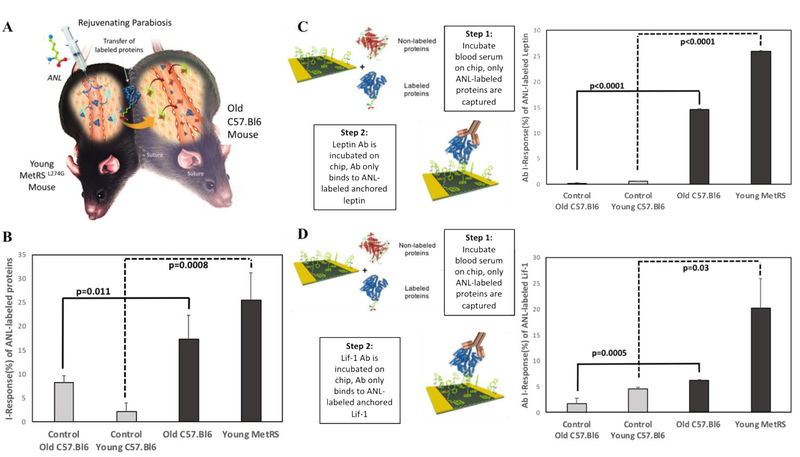Figure 5.

(A) Experimental setup of parabiosis between the young MetRS mouse and old C57.Bl6 mouse. (B) Click-A+Chip I-Response + SD in the presence of ANL-labeled proteins in both MetRSL274G / C57.Bl6 and control C57.Bl6 parabiotic mouse partners (old: p=0.01, n=3 control, experimental) (young: p=0.0008, n=2 control, 6 experimental). (C) The Click-A+Chip I-Response + SD after exposure to blood serum from young MetRSL274G and its old C57.Bl6 partner and subsequent exposure to Leptin specific antibodies indicated a 25% and 15% I-Response, respectively. The amount of labeled Leptin detected in serum from MetRSL274G and their C57.Bl6 parabiotic partners was significantly higher when compared with that of non-labeled young C57.Bl6 and old C57.Bl6 pair (old: p<0.0001, n=5 control, 3 experimental) (young: p<0.0001, n=2 control, 3 experimental). (D) Similarly, Click-A+Chip detected the presence of Lif-1 protein present in young MetRSL274G serum and old C57.Bl6 parabiotic partner serum. After exposure to Lif-1 antibodies, the sensor response indicated a 20% and 7% I-Response, respectively. The amount of labeled Lif-1 detected in serum from MetRSL274G and their C57.Bl6 parabiotic partners was significantly higher when compared with that of non-labeled young C57.Bl6 and old C57.Bl6 pair (old: 0.0005, n=5 control, 3, experimental) (young: p=0.03, n2 control, 3 experimental).
